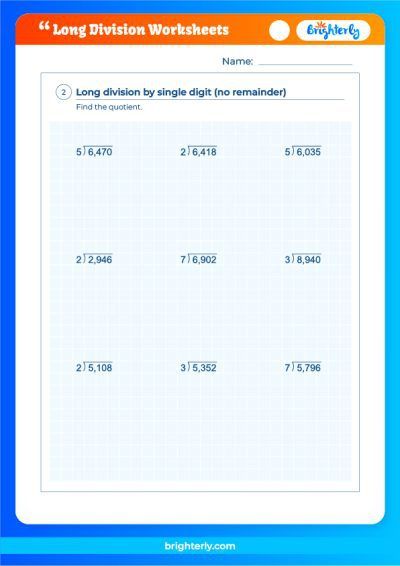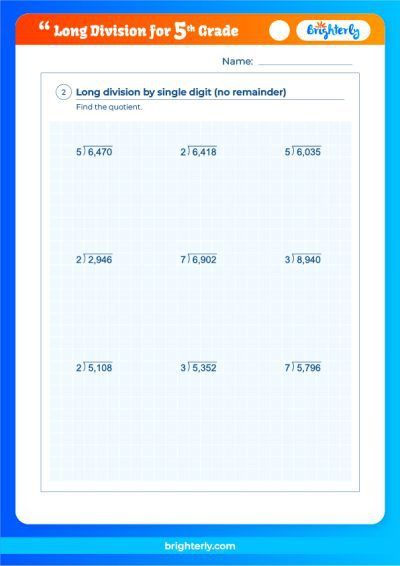Long Division – Definition, Steps, Method, Examples
Updated on January 13, 2024
Long division is a crucial arithmetic skill that paves the way for understanding more advanced mathematical concepts. At Brighterly, we believe in empowering children with the tools they need to excel in mathematics. In this comprehensive guide, we’ve crafted a step-by-step breakdown of the long division process, enriched with tips, tricks, and insights to simplify learning for children. Welcome to Brighterly’s all-inclusive long division masterclass!
What is Long Division Method?
The long division method is a powerful technique designed to tackle large numbers that are too cumbersome to divide mentally. This systematic approach dissects the problem into smaller, digestible steps, enabling us to conquer complex calculations with ease. By honing this vital skill, children lay a strong foundation for exploring more sophisticated mathematical concepts in the future.
At Brighterly, we understand that mathematics can sometimes feel overwhelming. That’s why we’ve developed our unique approach to long division, transforming it into an engaging and approachable topic for children. Through our carefully designed methods and interactive learning experiences, we aim to spark a love for math that lasts a lifetime. By making long division more accessible and enjoyable, we’re committed to helping children unlock their full potential in mathematics and beyond.
Parts of Long Division
Long division problems involve several key components:
- Dividend: The number being divided
- Divisor: The number by which the dividend is divided
- Quotient: The result of the division
- Remainder: The amount left over after the division
Understanding these parts is crucial to successfully solving long division problems.
How to do Long Division?
Follow these simple steps to solve a long division problem:
- Write the dividend and divisor in the long division format.
- Divide the dividend by the divisor, starting with the leftmost digit.
- Write the result (quotient) above the dividend.
- Multiply the divisor by the quotient and subtract the result from the dividend.
- Bring down the next digit and repeat the process until you reach the end of the dividend or the desired decimal places.
Long Division Steps
Here’s a breakdown of the long division process:
- Divide: Determine how many times the divisor can fit into the dividend.
- Multiply: Multiply the quotient by the divisor.
- Subtract: Subtract the product from the dividend.
- Bring down: Bring down the next digit from the dividend.
- Repeat: Continue the process until you reach the end of the dividend or the desired decimal places.
Division with Remainders
Division with remainders occurs when the divisor does not evenly divide the dividend, leaving a residual amount. Remainders can be expressed as fractions (with the divisor serving as the denominator) or as whole numbers, contingent on the context. Understanding division with remainders is essential for grasping real-world applications of division, as it showcases the intricacies of mathematical problem-solving.
At Brighterly, we’re dedicated to helping children comprehend the complexities of division with remainders, by providing a multitude of practical examples and engaging activities. Our tailored approach encourages children to explore various strategies and techniques for handling remainders, fostering a deeper appreciation for the power of mathematics.
Division without Remainder
Division without remainder signifies that the divisor evenly divides the dividend, resulting in a whole number without any residual amount. In these instances, the division is referred to as exact. Grasping the concept of division without remainders is crucial for building a solid understanding of whole number arithmetic.
Brighterly is committed to making division without remainder an approachable and enjoyable topic for children. Through our wide array of interactive learning experiences, we strive to help students develop a strong foundation in whole number arithmetic, setting them up for future success in more advanced mathematical concepts.
Long Division by a 2-Digit Number
Dividing by a 2-digit number follows the same procedure as dividing by a 1-digit number, with one key distinction: the need to account for the additional digit when comparing the dividend and divisor. Mastering long division by a 2-digit number is essential for tackling more challenging math problems with confidence.
At Brighterly, we prioritize helping children become proficient in long division by 2-digit numbers, by offering a plethora of engaging examples, practice problems, and interactive learning modules. Our innovative approach empowers students to tackle long division with ease, bolstering their mathematical abilities in the process.
Long Division of Polynomials
Long division isn’t limited to numbers; it can also be employed to divide polynomials. When dividing polynomials, you’ll work with variables and coefficients instead of numbers. Although the overall process remains the same, it’s crucial to remain vigilant about the rules of algebra when performing operations.
Brighterly is passionate about guiding children through the exciting world of polynomial long division. Our dynamic resources and captivating explanations simplify the process, enabling children to develop a profound understanding of algebraic concepts and techniques.
Long Division with Decimals
Dividing decimals closely resembles whole number division, with a few minor adjustments. First, convert the divisor into a whole number by shifting the decimal point to the right. Next, move the decimal point in the dividend the same number of places. Finally, proceed with the division as you would with whole numbers.
Brighterly specializes in making long division with decimals accessible and enjoyable for children. Through our comprehensive resources and stimulating activities, we aim to demystify decimal division and help children become proficient in this vital mathematical skill.
How to Divide Decimals by Whole Numbers?
To divide a decimal by a whole number, simply follow the standard whole number division process. The decimal point in the quotient will align directly above the decimal point in the dividend. Brighterly offers a range of engaging resources to help children master this essential skill, ensuring they’re equipped to tackle increasingly complex math problems.
Symbol of Division
The division symbol (÷) is utilized to denote division. In long division, the divisor is positioned outside the division symbol, while the dividend is placed inside. Understanding the proper usage of division symbols is critical for children as they progress in their mathematical journeys. At Brighterly, we are committed to fostering a strong foundation in mathematical notation and symbols.
Dividing Decimals Using Long Division
To divide decimals using long division, follow these steps:
- Adjust the divisor and dividend by moving their decimal points the same number of places to the right, making the divisor a whole number.
- Perform long division as you would with whole numbers.
- Place the decimal point in the quotient directly above the decimal point in the dividend.
Solved Examples on Long Division
Here are a few solved examples to help you understand long division better:
Example 1:
Divide 1275 ÷ 15
- Divide: 1 (leftmost digit) ÷ 15 = 0 (write 0 above the 1)
- Multiply: 0 × 15 = 0
- Subtract: 1 – 0 = 1
- Bring down: Bring down the 2 (12)
- Divide: 12 ÷ 15 = 0 (write 0 above the 2)
- Multiply: 0 × 15 = 0
- Subtract: 12 – 0 = 12
- Bring down: Bring down the 7 (127)
- Divide: 127 ÷ 15 = 8 (write 8 above the 7)
- Multiply: 8 × 15 = 120
- Subtract: 127 – 120 = 7
- Bring down: Bring down the 5 (75)
- Divide: 75 ÷ 15 = 5 (write 5 above the 5)
- Multiply: 5 × 15 = 75
- Subtract: 75 – 75 = 0 (no remainder)
The result is 85.
Example 2:
Divide 4.32 ÷ 6
- Adjust the divisor and dividend: Move the decimal point 0 places (divisor is already a whole number).
- Divide: 4 ÷ 6 = 0 (write 0 above the 4 and place the decimal point above the dividend’s decimal point)
- Multiply: 0 × 6 = 0
- Subtract: 4 – 0 = 4
- Bring down: Bring down the 3 (43)
- Divide: 43 ÷ 6 = 7 (write 7 above the 3)
- Multiply: 7 × 6 = 42
- Subtract: 43 – 42 = 1
- Bring down: Bring down the 2 (12)
- Divide: 12 ÷ 6 = 2 (write 2 above the 2)
- Multiply: 2 × 6 = 12
- Subtract: 12 – 12 = 0 (no remainder)
The result is 0.72.
Practice Problems on Long Division
Here are some practice problems to help you hone your long division skills:
- 364 ÷ 4
- 528 ÷ 6
- 2.64 ÷ 8
- 6.48 ÷ 3
- 1024 ÷ 16
Conclusion
At Brighterly, we believe that mastering long division is paramount for children to establish a robust foundation in mathematics. This vital skill not only equips them to tackle more advanced math concepts but also cultivates their problem-solving abilities, a valuable asset in all aspects of life. By comprehending the steps involved in long division and engaging in regular practice, children can develop confidence and proficiency in their mathematical skills.
Our mission at Brighterly is to create an immersive learning environment that fosters curiosity, creativity, and a passion for mathematics. Through our comprehensive resources, interactive activities, and expert guidance, we strive to make long division an approachable and enjoyable topic for children. We understand that each child is unique, and our tailored approach caters to individual learning styles, ensuring that every student can reach their full potential.
By investing in the development of strong long division skills, we’re not only empowering children to excel in mathematics but also setting them up for success in their academic and professional endeavors. Together, let’s inspire the next generation of mathematical thinkers, problem solvers, and innovators.
Frequently Asked Questions on Long Division
How can I help my child with long division?
Begin by ensuring they understand the basic concepts of division and the parts of a long division problem. Then, guide them through the steps, providing plenty of practice problems. Encourage them to check their work and learn from their mistakes.
What are some common mistakes made during long division?
Some common mistakes include:
- Misplacing the decimal point
- Incorrectly carrying over remainders
- Forgetting to bring down the next digit
- Not following the steps in the correct order
What are some tips for teaching long division?
Break the process down into smaller steps, use visual aids to illustrate the process, and provide real-life examples to make it more engaging. Encourage patience and persistence, as long division can be challenging at first.
Can long division be used for dividing polynomials and decimals?
Yes, long division can be used to divide both polynomials and decimals. The basic process remains the same, but you’ll need to pay attention to algebra rules when working with polynomials and adjust the divisor and dividend when dividing decimals.
Information Sources
The information in this article is compiled from various reputable sources, including:






